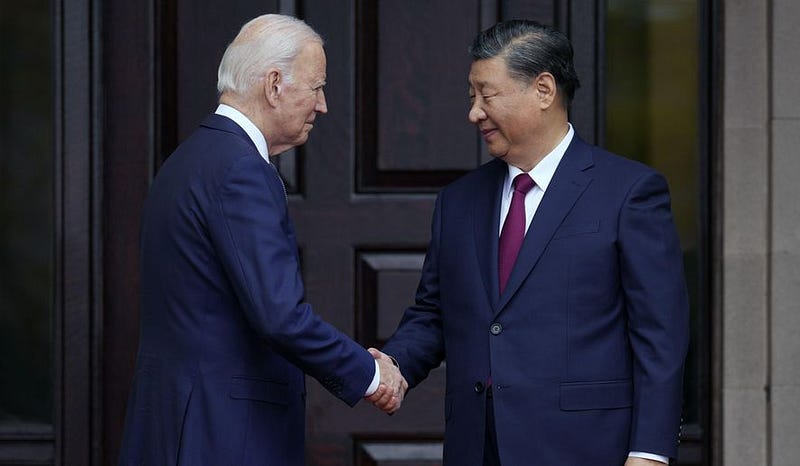In a bold and contentious move, President Joe Biden has escalated the trade war with China, intensifying tariffs on a range of Chinese imports in a bid to curb Beijing’s economic ascendancy and protect beleaguered American industries. This strategy, targeting products from electric vehicles to solar cells, underscores Biden’s commitment to countering China’s influence while addressing domestic economic concerns. The ramifications of this escalation are profound, reverberating through global markets and straining an already tenuous geopolitical landscape.
Biden’s policy, while echoing elements of Donald Trump’s trade war tactics, introduces a collaborative dimension, forging alliances with global partners to present a united front against China’s economic practices. This nuanced approach highlights the administration’s recognition of the trade war as a critical facet of the broader US-China rivalry, which transcends economics to encompass geopolitical and technological dominance.
The Historical Roots of US-China Trade Disputes
The genesis of the current trade tensions stretches back to China’s accession to the World Trade Organization (WTO) in 2001, a move anticipated to integrate China into the global trading system and compel economic reforms. Contrary to expectations, this integration exacerbated trade imbalances and accelerated the outsourcing of American manufacturing jobs — a phenomenon often described as the “China Shock.”
The Obama administration’s “Pivot to Asia” strategy, aimed at rebalancing US foreign policy towards the Asia-Pacific, further inflamed tensions. Central to this pivot was the Trans-Pacific Partnership (TPP), conspicuously excluding China. Although the TPP was abandoned by the Trump administration, the objective of countering China’s regional influence persisted, setting the stage for ensuing conflicts.
The Trump administration’s initiation of a trade war in 2018 marked a significant escalation, characterized by tariffs on billions of dollars of Chinese goods. This aggressive stance aimed to rectify trade deficits and compel China to reform practices such as intellectual property theft and forced technology transfers. Beijing’s retaliatory tariffs exacerbated these tensions, laying a complex and volatile groundwork inherited by the Biden administration.
Biden’s Calculated Escalation: Protecting American Interests
President Biden’s heightened tariffs on Chinese imports represent not just a continuation but an evolution of Trump’s policies, pivoting towards a strategic multilateral approach. By framing the trade dispute within the broader context of countering China’s global ascendancy, Biden underscores the multifaceted nature of the conflict, encompassing economic, military, and technological dimensions.
The heightened tariffs, particularly on sectors like electric vehicles and solar cells, align with Biden’s domestic agenda of fostering green energy and revitalizing manufacturing. By insulating these burgeoning industries from Chinese competition, the administration aims to enhance the competitiveness of American products and safeguard domestic employment. This protectionist stance, however, must be carefully balanced to avoid exacerbating inflationary pressures domestically.
Diverging from Trump’s unilateral tactics, Biden’s strategy hinges on coalition-building, enlisting allies from Europe and Asia to address trade imbalances and counteract China’s economic maneuvers. This coordination is designed to amplify pressure on Beijing, leveraging collective economic might to influence Chinese policies and curb its unilateral actions on the global stage.
Economic and Global Ramifications
The intensifying trade war portends far-reaching consequences for the global economy. Disruptions in global supply chains, particularly in vital sectors like technology and manufacturing, are a primary concern. The imposition of higher tariffs and ensuing retaliations are likely to drive up costs for global businesses and consumers, compelling companies to reassess their production and distribution strategies.
Commodity prices, especially for critical minerals indispensable to technology and renewable energy industries, are at risk of volatility amid supply chain disruptions. The current global shortages of these essential resources could be further aggravated by the trade war, escalating the economic impact across sectors dependent on these materials.
Beyond immediate economic repercussions, the trade war may catalyze a reconfiguration of global trade alliances. Nations, wary of over-reliance on either the US or China, may pursue diversification, forging new trade agreements that reshape existing economic paradigms.
Political Dimensions and the 2024 Election Landscape
Biden’s stringent stance on China extends beyond economic strategy, doubling as a politically astute move aimed at resonating with American workers disillusioned by globalization. This hardline approach is especially pertinent as the nation approaches the November 2024 elections, with trade and economic policies poised to be pivotal campaign issues.
The trade war’s implications for US international relations are equally significant. By orchestrating a cohesive response to China’s economic practices with allied nations, Biden aims to reinforce US global leadership and challenge Beijing’s expanding influence. This geopolitical maneuvering is emblematic of a broader rivalry encompassing technological, military, and ideological spheres.
Steering Through Turbulence: Domestic Imperatives and Global Stability
Biden’s escalation of the trade conflict with China encapsulates a strategic attempt to address national economic concerns while mitigating broader geopolitical risks. Protecting American industries and jobs through heightened tariffs is fraught with the potential to inflate consumer costs and deepen domestic economic strains.
Despite unilateral measures, Beijing’s retaliatory actions signal prolonged tensions. The long-term prospects of this trade war for both global economics and US-China relations remain unpredictable. The international community watches closely as this economic and geopolitical rivalry unfolds, with each maneuver capable of redefining global economic stability.
Amid these profound challenges, policymakers must navigate a delicate equilibrium, balancing the imperatives of protecting domestic interests against the necessity of maintaining global stability. Strategic, nuanced policies will be crucial to prevent the trade war from spiraling into an uncontrollable force, potentially destabilizing the fragile dynamics of the global economic order.
In conclusion, the trade war’s resolution requires a blend of strategic foresight, international collaboration, and nuanced understanding of the complex interplay between economic and geopolitical factors. Diplomatic efforts, coupled with strategic economic measures, are essential to crafting a sustainable path forward, ensuring that both domestic and global interests are safeguarded within this volatile landscape.









